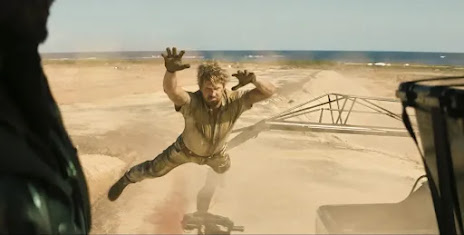 |
| Cristin Milioti and Andy Samberg |
Max Barbakow's Palm Springs, from 2020, is a time loop comedy that boasts both hilarity and depth. A perverse riff on Groundhog Day, Palm Springs has Andy Samberg reliving the same desert resort wedding day in perpetuity. He seizes the opportunity to drink excessively and seduce who he can within the wedding party. Unlike Groundhog Day, Samberg is joined in the loop by a nemesis (J.K. Simmons) and a romantic interest (Cristin Milioti). Andy Siara's witty script uses an outlandish premise, as in classic screwball comedies, to poke fun at American mores. Despite a major flaw, Palm Springs is one of the better American comedies of this century.
Unfortunately, that flaw is Mr. Samberg. I feel bad for kicking a man when he is down. After the results of the recent election, it looks like he will lose his gig on Saturday Night Live playing Doug Emhoff. Palm Springs shows that the parodies and skits of SNL and The Lonely Island are a better home for his talents than playing a romantic lead, even in a goofy comedy. Bill Murray's performance in Groundhog Day lets the audience in on the joke. He allows them to see he is playing a naughty brat who must be reformed before experiencing mature love. All we get from Samberg, whether he is clutching a beer or Ms. Milioti, is a smug smirk. Whenever charm and grace are needed, as when Samberg maneuvers through the reception throng to catch Ms. Milioti's eye, Samberg falls woefully short. Since this film is Samberg's and Siara's baby, nurtured since their AFI days, I feel doubly bad about pointing out the obvious.
Ms. Milioti, however, is superb in a modern take on a screwball heroine that makes us laugh and empathize with her character's plight. Her character is more morally ambivalent than the screwball heroines of past, but Ms. Milioti, as she has shown on The Penguin, is adept at bringing steel and ice to a character. Hulu has kept a tight wrap around Palm Springs since its truncated theatrical run, there seems to be no DVD or Blu-ray release in the US, but it seems that Hollywood is catching onto Ms. Milioti's varied talents.
One of the possible reasons for the lack of a disc release for Palm Springs, its music licensing, is a strength of the film. The song selections, which range from Hawaiian tunes to Patrick Cowley, comments on the action in a more interesting fashion than in most pop films of this ilk. Some of the tunes reinforce a mood, Gram Parsons' In My Hour of Darkness plays at the bar when Samberg, at his lowest ebb, drowns his sorrows. John Cale's Barracuda, ostensibly upbeat, plays up the sexual and social one-upmanship surrounding the film's wedding and reception. Most interesting of all is the use of Gene Clark's No Other while Samberg reminisces about how he and J.K. Simmons once went on a bender, snorting up half of Bolivia. The song and attendant album are permeated by cocaine's highs and lows. The song's lyrics, like Palm Springs, grapple with the push and pull of sexual fidelity.
Simmons is always a valuable asset to a film, but Palm Springs brings together a host of scene stealers: including Meredith Hagner, Tyler Hoechlin, June Squibb, and Peter Gallagher. Barbakow keeps things at an antic pace without getting out of control. I think the film was poorly marketed, Palm Desert or Joshua Tree have been better titles for the film. Palm Springs as a title smacks more of Sinatra than the aliens and magic mushrooms that figure in the film itself. Nevertheless, this is a picture that will only gain in esteem in the future.



























